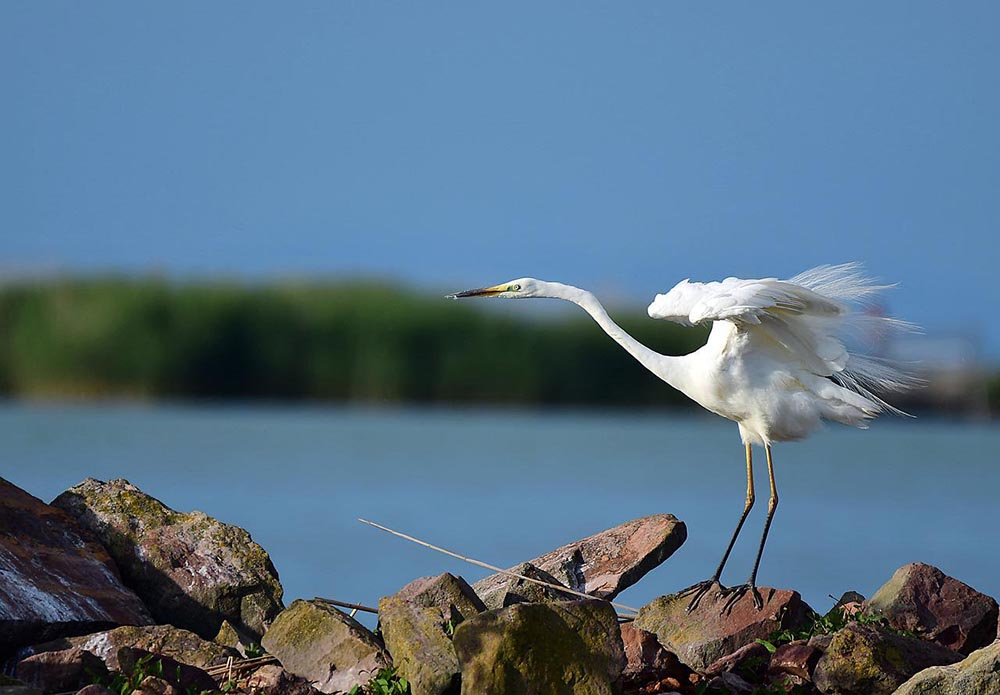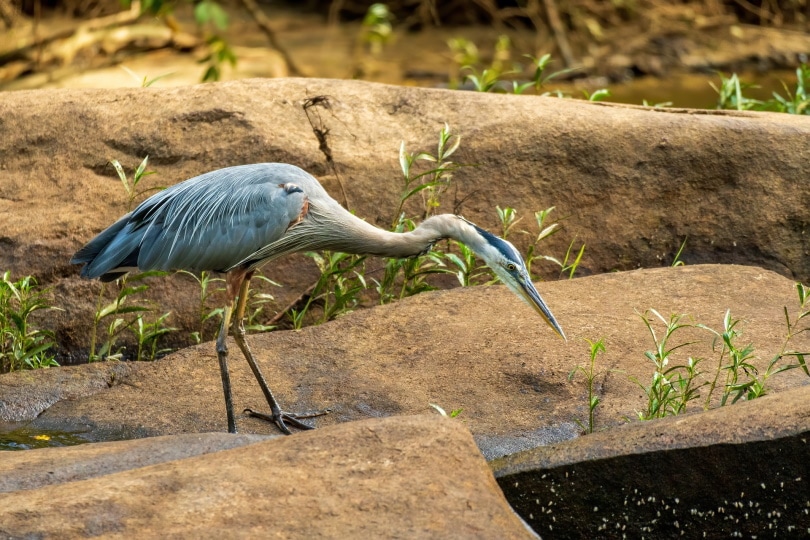10 Fun & Interesting Heron Facts
Last Updated on

Herons are long-legged, long-necked coastal birds that are medium to large in size. They are carnivorous birds that thrive in wetland habitats, where they use impressive hunting skills to capture live aquatic prey such as fish, frogs, snakes, and lizards. These prehistoric-looking birds can be spotted perched on the edge of streams, ponds, and other bodies of water.

1. Herons thrive in fresh and saltwater environments

Herons call the coastlines of both fresh and saltwater environments their homes. They do not mind where they fish and often switch between fishing spots in salty marshes, brackish estuaries, and freshwater lakes.
2. Herons live in colonies of up to 500 birds
Members of the heron family generally nest together in groups called “heronries” or “rookeries.” On average, these groups contain about 160 individuals, although they can range anywhere between 5 and 500 birds.
3. There are 72 different species of Herons
Herons are a part of the family Ardeidae, which includes 72 recognized species. These birds include herons, egrets, and bitterns, as determined by the International Ornithological Congress (IOC). The species is divided into 18 genera.
4. Herons use a special “toothed” toenail to comb and clean their feathers

Herons have a serrated nail on their middle toe which they use as a “comb” to groom and clean their feathers. They use this nail to remove parasites, scratch themselves, and ensure all of their feathers are lying flat and smooth.
5. Herons can see in the dark
The heron gives “bird’s eye view” a whole new meaning. In addition to lightning-quick reactions, herons rely on their incredible eyesight to make catching prey easy. A heron’s eyesight is about three times sharper than a human’s, enabling them to see extensive details and enhance their depth perception. Their eyes also have built-in “zoom lenses,” allowing them to switch between macro and telescopic vision quickly.
6. Male Herons collect nesting material
Male herons will usually be the ones to either build or colonize an existing nest. At the beginning of the breeding season, males will settle into their nest and attempt to court and woo the females passing by.
7. Herons are carnivores

Although a heron’s diet consists exclusively of marine animals, their diet is still incredibly varied and changes depending on where they live. In general, herons are happy to eat anything that they can swallow, given it is moving. Some of their favorite foods include fish, crayfish, shrimp, crabs, small birds, frogs, toads, lizards, rodents, worms, snakes, and grasshoppers. Herons prefer to swallow their prey whole, but larger prey is torn up and swallowed in big chunks.
8. Herons are excellent flyers
Herons are speedy birds that can fly as fast as 30 miles per hour. They generally keep their necks in an “S” shape and push their legs out straight behind them when in flight.
9. Herons are monogamous
Most heron species are monogamous, meaning they keep the same breeding partners year after year. Generally, herons breed in colonies and build their nests high above the ground, making them inaccessible to predators such as alligators. Heron nests are usually built from sticks and can be up to 3 feet across.
10. Herons use their beaks like a dagger to hunt for fish
Herons are excellent and intelligent hunters that are most active during dawn and dusk. They are near the top of the food chain due to their superb hunting skills and have a few tricks up their feathers. Herons have a very sharp and pointed beak which they use as a dagger to stab their prey. Additionally, it is common to see herons with their wings up and spread out. This is performed to cast shadows that reduce glare on the water, confusing their prey and making it easier for them to see. Herons have also been observed using bait to lure their prey closer to their demise.

Summary
Herons are majestic creatures that are a common sight to those living near water. They are some of the largest birds around, and their elegant and recognizable silhouettes are easy to make out against the sky as the sun rises and sets. Herons are intelligent, skilled hunters revered by the animal kingdom due to their status near the top of the food chain. Next time you’re near a body of water, see if you can spot a heron putting its impressive hunting skills to the test.
See Also: 13 Interesting and Fun Great Blue Heron Facts You Never Knew
Featured Image Credit: Steve001, Pixabay
Table of Contents
- 1. Herons thrive in fresh and saltwater environments
- 2. Herons live in colonies of up to 500 birds
- 3. There are 72 different species of Herons
- 4. Herons use a special “toothed” toenail to comb and clean their feathers
- 5. Herons can see in the dark
- 6. Male Herons collect nesting material
- 7. Herons are carnivores
- 8. Herons are excellent flyers
- 9. Herons are monogamous
- 10. Herons use their beaks like a dagger to hunt for fish
- Summary
About the Author Robert Sparks
Robert’s obsession with all things optical started early in life, when his optician father would bring home prototypes for Robert to play with. Nowadays, Robert is dedicated to helping others find the right optics for their needs. His hobbies include astronomy, astrophysics, and model building. Originally from Newark, NJ, he resides in Santa Fe, New Mexico, where the nighttime skies are filled with glittering stars.
Related Articles:
10 Types of Hummingbirds in Arkansas (With Pictures)
8 Types of Hummingbirds in Nebraska (With Pictures)
5 Types of Hummingbirds in Idaho (With Pictures)
3 Types of Hummingbirds in Mississippi (With Pictures)
8 Types of Hummingbirds in Kansas (With Pictures)
5 Types of Hummingbirds in West Virginia (With Pictures)
5 Types of Hummingbirds in Ohio (With Pictures)
Where Do Nuthatches Nest? Nuthatch Nesting Habits Explained
